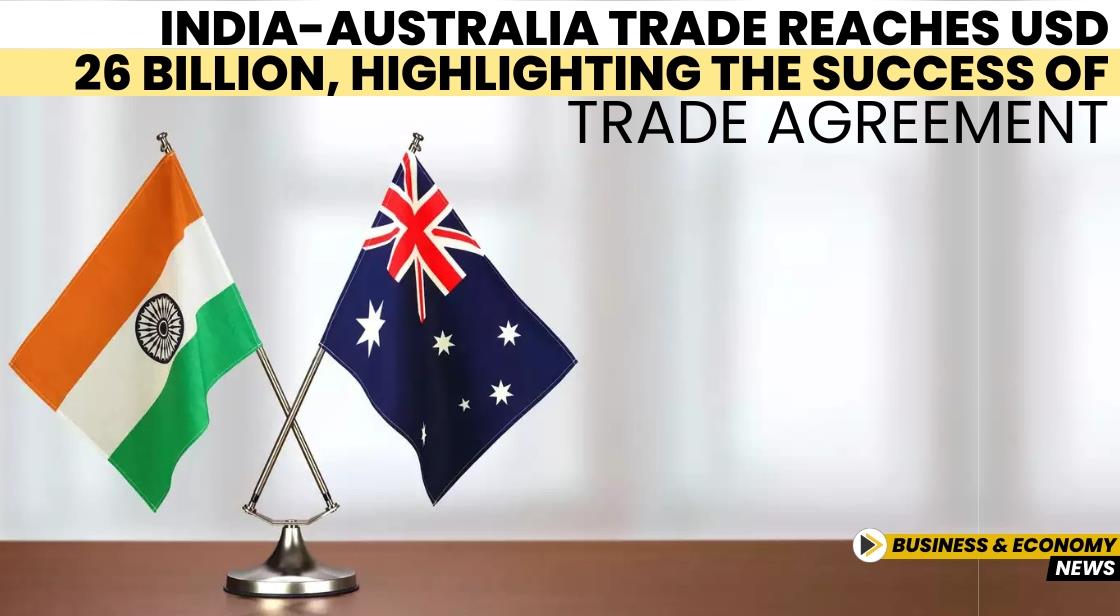India-Australia Trade Reaches USD 26 Billion, Highlighting the Success of Trade Agreement

News Synopsis
The India-Australia Economic Cooperation and Trade Agreement (Ind-Aus ECTA) has marked a significant milestone in bilateral relations, completing two years of successful implementation. Since its signing, the agreement has played a crucial role in strengthening the economic ties between the two nations, creating new opportunities for businesses, MSMEs, and employment, and providing a solid foundation for continued economic partnership.
Surge in Bilateral Trade
One of the most notable outcomes of the ECTA is the dramatic growth in bilateral merchandise trade. In the two years since the agreement's implementation, trade between India and Australia has more than doubled, rising from USD 12.2 billion in 2020-21 to USD 26 billion in 2022-23. Although trade saw a slight moderation in 2023-24, with the total reaching USD 24 billion, India’s exports to Australia continued to grow by 14%, maintaining robust momentum. By November 2024, the total merchandise trade between the two nations stood at USD 16.3 billion, demonstrating the continued positive trajectory of their economic relationship.
Impact of Preferential Import Data Exchange
A significant aspect of the ECTA's success is the preferential import data exchange, which was launched in 2023. The data highlights the efficiency and effectiveness of the trade agreement, with export utilization reaching 79% and import utilization at 84%. This exchange underscores the positive impact of the ECTA in streamlining trade and ensuring that both countries benefit from preferential access to each other’s markets.
Growth in Key Sectors
Several key sectors have seen substantial growth under the ECTA. These include textiles, chemicals, and agriculture, where both India and Australia have enhanced their trade volumes. In addition, new exports such as gold-studded diamonds and turbojets signal a diversification in trade activities between the two countries. These developments reflect the broadening scope of trade beyond traditional sectors, opening new avenues for future collaboration.
India’s Imports: Critical Raw Materials
India’s imports from Australia have also been a key component of the bilateral trade success. The importation of critical raw materials, including metalliferous ores, cotton, and wood products, has been vital for India’s industrial growth. These imports help support various sectors in India, including manufacturing, textiles, and construction, which rely heavily on these raw materials for their operations. The trade in such essential materials strengthens the mutually beneficial nature of the India-Australia partnership.
Expanding Trade Potential: Electronics and Engineering
Looking ahead, there is significant potential for further growth in sectors such as electronics and engineering. Both countries recognize the opportunity for increased trade in these areas, particularly given the growing demand for technological and industrial products. As industries in both nations continue to evolve, the potential for collaboration in these high-tech sectors becomes increasingly promising.
The Progress of the Comprehensive Economic Cooperation Agreement (CECA)
Building on the achievements of the ECTA, both countries are now focused on the India-Australia Comprehensive Economic Cooperation Agreement (CECA). The CECA is designed to further enhance economic relations between India and Australia, and ten formal rounds of discussions have already taken place. In addition to these rounds, inter-sessional talks have helped push the negotiations forward. A stocktake visit to New Delhi in December 2024 allowed both nations to assess the progress made on the CECA and chart the next steps in the ongoing negotiations.
Achieving USD 100 Billion in Bilateral Trade by 2030
Both India and Australia are committed to further expanding their economic partnership. One of the shared goals is to achieve USD 100 billion in bilateral trade by 2030. This ambitious target highlights the growing importance of India and Australia’s trade relationship and their determination to capitalize on the potential for mutual growth.
Conclusion
The India-Australia Economic Cooperation and Trade Agreement (Ind-Aus ECTA) has proven to be a successful initiative, boosting bilateral trade and opening new avenues for economic collaboration. With continued efforts on the CECA and a focus on key growth sectors, both countries are well on their way to achieving their trade target of USD 100 billion by 2030. The success of this partnership is not only reflected in increased trade figures but also in the new opportunities created for businesses, industries, and workers in both nations.
You May Like









